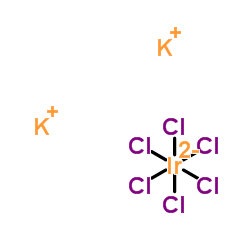Dipotassium hexachloroiridate(2-)

Dipotassium hexachloroiridate(2-) structure
|
Common Name | Dipotassium hexachloroiridate(2-) | ||
|---|---|---|---|---|
| CAS Number | 16920-56-2 | Molecular Weight | 483.132 | |
| Density | 3,546 g/cm3 | Boiling Point | N/A | |
| Molecular Formula | Cl6IrK2 | Melting Point | >385 °C(lit.) | |
| MSDS | Chinese USA | Flash Point | N/A | |
| Symbol |

GHS07 |
Signal Word | Warning | |
|
Insertion of dGMP and dAMP during in vitro DNA synthesis opposite an oxidized form of 7,8-dihydro-8-oxoguanine.
Nucleic Acids Res. 27(2) , 496-502, (1999) Oxidative damage to DNA bases commonly resultsin the formation of oxidized purines, particularly 7,8-dihydro-8-oxoguanine (8-oxoG) and 7,8-dihydro-8-oxoadenine (8-oxoA), the former being a well-known mutagenic lesion. Since 8-oxoG is readily subject to furthe... |
|
|
Proton-coupled electron-transfer oxidation of phenols by hexachloroiridate(IV).
Inorg. Chem. 47(24) , 11458-60, (2008) One-electron oxidation of phenol, 2,4,6-trimethylphenol, and 2,6-dimethylphenol by [IrCl(6)](2-) in aqueous solution has a simple pH dependence, indicating slow bimolecular oxidation of ArOH and faster oxidation of ArO(-). H/D kinetic isotope effects as large... |
|
|
Pseudohalide anions reveal a novel extracellular site for potentiators to increase CFTR function.
Br. J. Pharmacol. 167(5) , 1062-75, (2012) There is great interest in the development of potentiator drugs to increase the activity of the cystic fibrosis transmembrane conductance regulator (CFTR) in cystic fibrosis. We tested the ability of several anions to potentiate CFTR activity by a novel mecha... |
|
|
Gel electrophoretic detection of 7,8-dihydro-8-oxoguanine and 7, 8-dihydro-8-oxoadenine via oxidation by Ir (IV).
Nucleic Acids Res. 26(9) , 2247-9, (1998) Two gel electrophoretic methods are described for detection of 7, 8-dihydro-8-oxoguanine and 7,8-dihydro-8-oxoadenine based on their further oxidation with one-electron oxidants including IrCl62-and IrBr62-. The products of nucleobase oxidation lead to enhanc... |
|
|
The superoxide reductase from the early diverging eukaryote Giardia intestinalis.
Free Radic. Biol. Med. 51(8) , 1567-74, (2011) Unlike superoxide dismutases (SODs), superoxide reductases (SORs) eliminate superoxide anion (O(2)(•-)) not through its dismutation, but via reduction to hydrogen peroxide (H(2)O(2)) in the presence of an electron donor. The microaerobic protist Giardia intes... |
|
|
Electrochemistry of Q-graphene.
Nanoscale 4(20) , 6470-80, (2012) A newly synthesised type of graphene, Q-Graphene, has been physically and electrochemically characterised with Scanning and Transmission Electron Microscopy (SEM, TEM), X-ray Photoelectron Spectroscopy (XPS) and Cyclic Voltammetry (CV). Interpretation of SEM,... |
|
|
In vitro nucleotide misinsertion opposite the oxidized guanosine lesions spiroiminodihydantoin and guanidinohydantoin and DNA synthesis past the lesions using Escherichia coli DNA polymerase I (Klenow fragment).
Biochemistry 41(51) , 15304-14, (2002) The low redox potential of 8-oxo-7,8-dihydroguanine (OG), a molecule regarded as a marker of oxidative damage in cells, makes it an easy target for further oxidation. Using a temperature-dependent method of synthesis, the oxidation products of OG, guanidinohy... |
|
|
Oxidation of glutathione by hexachloroiridate(IV), dicyanobis(bipyridine)iron(III), and tetracyano(bipyridine)iron(III).
Inorg. Chem. 51(24) , 13303-11, (2012) The aqueous oxidations of glutathione (GSH) by [IrCl(6)](2-), [Fe(bpy)(2)(CN)(2)](+), and [Fe(bpy)(CN)(4)](-) are described. All three reactions are highly susceptible to catalysis by traces of copper ions, but this catalysis can be fully suppressed with suit... |
|
|
Influence of redox molecules on the electronic conductance of single-walled carbon nanotube field-effect transistors: application to chemical and biological sensing.
J. Am. Chem. Soc. 130(12) , 3780-7, (2008) In an effort to develop sensitive nanoscale devices for chemical and biological sensing, we have examined, using liquid gating, the conductance of semiconducting single-walled carbon nanotube-based field-effect transistors (SWCNT-FETs) in the presence of redo... |
|
|
Kinetic mechanism of the Cu(II) enzyme galactose oxidase.
J. Inorg. Biochem. 14(3) , 209-22, (1981) The steady-state kinetics of four redox reactions catalyzed by galactose oxidase have been determined. The alcohol substrate used in each case was galactose; the four oxidant substrates used were O2, IrCl6(2)-, porphyrexide, and Fe(CN)6(3)-. With the exceptio... |